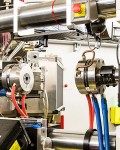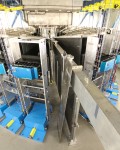Neutron scattering, capable of looking deep inside the structures of materials used in technologies such as batteries and fuel cells, is a natural tool for research in energy storage and production. Several users of neutron scattering instruments at the SNS and HFIR presented details of their energy-related research to prospective scientific facility users attending the opening session of ORNL’s User Week at SNS.
Most of the energy-related research reported in the session dealt with batteries for electric and hybrid electric cars. Better batteries are also needed for storing excess electricity generated by wind and solar power so it can be used by the electric grid when the wind dies down or the sky is cloudy or dark.
BASIS, the Backscattering Spectrometer at SNS, has been used to identify several distinct dynamic components in room-temperature ionic liquids (RTILs) in bulk form. Research at one of DOE’s Energy Frontier Research Centers (Fluid Interface Reactions, Structures, and Transport Center) at ORNL is studying RTILs confined in carbon nanopores and mesoporous media. RTILs have potential as an ionic charge-carrying media for advanced batteries and supercapacitors.
The lithium-ion batteries currently used, which power electronic devices ranging from cell phones to electric cars, are valued for their low weight, high energy density, and recharging ability. Researchers hope to extend battery performance by lending engineers a finely tuned knowledge of battery components and dynamics.
Neutron scattering is being used to uncover changes in the structure of parts of a lithium-ion battery during charging and discharging. In situ neutron diffraction measurements at SNS reveal atomic-scale and nanoscale structural features in electrical energy storage materials. “The outcome of this study should be knowledge applicable to the design of next-generation batteries with dramatically improved capacity and longer lifetimes,” said Ian Anderson, Associate Laboratory Director for Neutron Sciences.
Xun-Li Wang, instrument scientist for the Vulcan engineering diffractometer at SNS said Vulcan, small-angle neutron scattering, and neutron imaging are being used to study residual stress, structural evolution, and phase transformation during temperature changes in lithium-ion battery materials.
A neutron imaging instrument at ORNL’s High Flux Isotope Reactor can map two- and three-dimensional lithium distribution and transport in battery electrodes and reveal degradation of battery materials during charging and discharging. The imaging tool is an integral part of four user projects at HFIR.
Ashfia Huq, instrument scientist for the POWGEN powder diffractometer at SNS, conducts in situ measurements to mimic the operational conditions of hydrogen fuel cells that could be used to supply electricity to buildings. “Fuel cells have higher energy densities than batteries and recharge more quickly,” she said. Her interest is in solid oxide fuel cells (SOFCs) used for stationary power. SOFCs can be fueled with syngas, a combination of hydrogen and carbon monoxide.
The goal is to investigate materials that have the potential to lower the SOFC operational temperature so inexpensive stainless steel can replace more costly materials in the fuel cell package. Huq has been using POWGEN, which opened to users in 2010, to determine changes in crystal structure as a function of temperature in lanthanum-strontium-manganese oxide for the cathode, nickel and yttria-stabilized zirconia for the anode, and YSZ for the solid electrolyte.
YSZ is used as the solid electrolyte because it enables the conduction of negative oxygen ions while blocking electron conduction. To achieve sufficient ion conduction, an SOFC with aYSZ electrolyte must be operated at high temperatures (800–1000°C), a major barrier to SOFC commercialization. Huq is using POWGEN to study cesium oxide, a potential alternative to YSZ.
Jung-Hyun Kim, a researcher in ORNL’s Neutron Scattering Sciences Division, has been using POWGEN to study proton conduction in SOFCs and to examine a new SOFC cathode material that might make it possible to reduce the SOFC operating temperature to below 800°C and lower the cost of the material used. Kim examined an yttrium, barium, cobalt, and oxygen compound (YBaCo4O7) doped with cobalt and zinc at a temperature range of 25 to 800°C. The results showed that adding zinc to the compound allowed the cathode material to function at a lower temperature.
Kim said POWGEN is useful for studying changes in the structure of energy-related crystalline materials under varying conditions. It can be employed to help identify materials that effectively capture carbon, clathrates that store gas, and zeolites that best isolate nuclear waste from the environment.
This research was funded by the U.S. Department of Energy (DOE) Office of Basic Energy Sciences.








